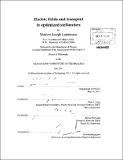Electric fields and transport in optimized stellarators
Author(s)
Landreman, Matthew Joseph
DownloadFull printable version (9.269Mb)
Other Contributors
Massachusetts Institute of Technology. Dept. of Physics.
Advisor
Peter J. Catto and Miklos Porkolab.
Terms of use
Metadata
Show full item recordAbstract
Recent stellarator experiments have been designed with one of two types of neoclassical optimization: quasisymmetry or quasi-isodynamism. Both types of stellarator have perfectly confined collisionless particle orbits as well as one additional feature. Quasisymmetric plasmas have minimal flow damping, which may lead to reduced turbulent transport. Quasi-isodynamic plasmas can have vanishing bootstrap current, implying less variation in the magnetic configuration as the pressure changes and also implying greater stability. Analytical expressions for neoclassical transport in a general stellarator are complicated, so it is desirable to find reduced expressions for ideal limiting cases to provide insight. Here, new neoclassical expressions are derived for a quasi-isodynamic plasma. The Pfirsch-Schliiter flow and current can be written concisely as an integral of B. The remaining components of the flow and bootstrap current are identical to those in a quasi-poloidally symmetric device. A compact expression is derived for the radial electric field Er which is largely independent of the details of the magnetic field. Another issue in the neoclassical theory of stellarators which has not been fully resolved is the validity of the so-called monoenergetic approximation, in which ad-hoc changes are made to Er terms in the kinetic equation to expedite numerical computations. Here we show that at least in a quasisymmetric plasma, this approximate treatment of Er leads to a significant and systematic underestimation of the trapped particle fraction. This distortion of the collisionless orbits is independent of any approximations made to the collision operator. For ideal quasisymmetric and quasi-isodynamic plasmas, new neoclassical expressions are derived in which this problematic monoenergetic approximation is avoided. In the quasisymmetric case, results are presented in both the banana regime and plateau regime for the ion flow, ion radial heat flux, and bootstrap current. The bootstrap current is found to be enhanced. For the quasi-isodynamic case, new Er-driven contributions to the distribution function are obtained. The flow and bootstrap current turn out to be modified by the same numerical coefficient as in the quasisymmetric case.
Description
Thesis (Ph. D.)--Massachusetts Institute of Technology, Dept. of Physics, 2011. Cataloged from PDF version of thesis. Includes bibliographical references (p. 119-124).
Date issued
2011Department
Massachusetts Institute of Technology. Department of PhysicsPublisher
Massachusetts Institute of Technology
Keywords
Physics.